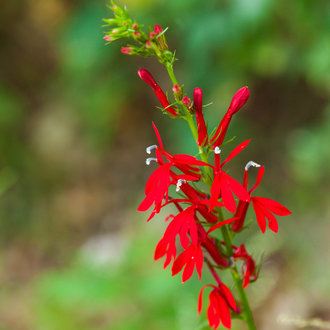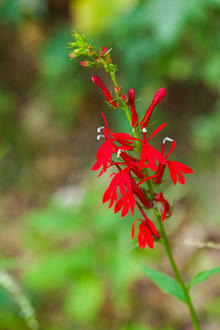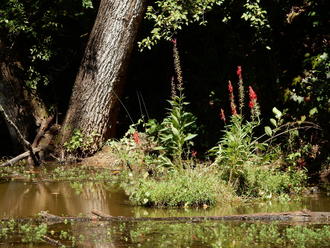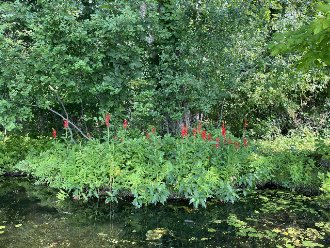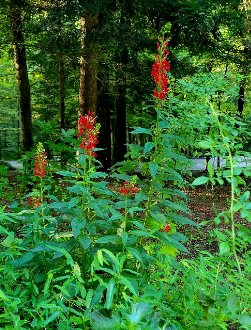Cardinal Flower (Lobelia cardinalis L.)
Also known as cardinalflower.
↑Summary
A perennial of wet, sunny to partly-sunny habitats, with scarlet-red flowers. Native to a wide range in North America.
↑Range - Expand
| Legend | Color |
| Native | |
| Native or Not Present |
This tentative map is based on our own research. It may have limited data on Canada and/or Mexico, and there is some subjectivity in our assignment of plants as introduced vs. expanded. Read more in this blog post.
Although this plant occurs somewhere in each of these regions, it may only occur in a small part of some or all of them.
This species is also native to Canada and Mexico; we have yet to build these portions of its map.
↑Description & Identification
Flowers are usually scarlet red, uncommonly white, and even more rarely, pink. The typical red form of this plant is distinctive and easily identified. Young plants however, prior to blooming, can easily be confused with other lobelias, and even numerous other herbaceous plants.
↑Habitat
Cardinal flower occurs in a wide range of wet to moist, sunny to partly-sunny conditions over a wide range from Canada into Central America, ranging much farther north in the east. Natural habitats include openings in floodplains and bottomland forests, swamps, wet meadows, shorelines of rivers, streams, lakes, and ponds, wet prairies and swales in grasslands, marsh margins, and seeps and springs. It is occasionally found in anthropogenic habitats, including roadside ditches and wet spots in gardens, where it can self-seed from garden plantings, as well as occurring naturally.
This plant always prefers moist to wet sites, but is restricted to wetlands in parts of its range, including in the arid west, the northernmost portions of its range, and on full sun sites anywhere in its range. However in the heart of its range in the humid east, on partly-shaded sites it sometimes ranges slightly onto drier ground. It tolerates both fast-moving, deep flooding (such as occurs along some rivers and streams) as well as longer periods of waterlogged soil and shallow (to 1-2 inches) standing water, especially during the cool season.
Cardinal flower is mostly indifferent to soil texture as long as the soil has sufficient organic matter. It can be found on many soil textures including sand, loam, gravel, clay, and muck, and various mixtures thereof. However, especially on sandy, clayey, or rocky soils it demands more organic matter in the soil to hold water during dry spells. It is more indifferent of soil pH than other lobelias that favor moist sites. It ranges into higher pH conditions than downy lobelia (Lobelia puberula), and lower pH conditions than great blue lobelia (Lobelia siphilitica), overlapping in range with both species, but generally being restricted to moister sites than the range of sites either of these species inhabits.
It is highly resistant to browsing by mammals and can thrive in overbrowsed areas.
↑Life Cycle
Cardinal flower is usually a short-lived perennial but its short lifespan is more of a function of its dynamic habitat; lucky plants can sometimes be longer-lived.
The tiny seeds germinate only when on or near the soil surface. In much of its range, seeds usually germinate in the spring, following a period of cold dormancy; we have not been able to find information on whether or not its seeds can germinate earlier, but it is possible that seeds may germinate earlier under certain conditions, at least in certain parts of its range. Plants initially form a basal rosette and may either not bloom, or produce only a short stem with few blooms in their first year.
Established plants send up flowering stems during the warm part of the growing season. There is usually one stem per rosette. Plant height is highly variable as a function of moisture availability, competition, and how well-established each plant is. Plants grow taller on moister, richer, better-drained sites with more competing vegetation. On favorable site, plants will reproduce vegetatively, forming multiple winter rosettes which will become flowering stems in future years. Rosettes are evergreen in most of its range.
Plants can die from many different causes. Seedlings are particularly fragile and mortality is high, often caused by out-competition from other plants or even caused by the plants getting buried by coarse leaf litter. On drier sites, even on sites that are usually moist but become dry for prolonged periods during certain years, plants can succumb to drought. On mesic sites with consistently good drainage, plants usually get out-competed and shaded out by other vegetation, either woody plants or taller herbaceous plants. Plants on wetter sites can also be killed by prolonged flooding.
↑Faunal Associations
Mammalian herbivores usually ignore this plant because of the toxicity of its foliage. This flowers are one of the best flowers for attracting hummingbirds, the ruby-throated hummingbird (Archilochus colubris) in most of its range, some others in the southwest; hummingbirds are the best pollinators of this plant, and they also highly value its nectar. The flowers also attract some larger butterflies, including various swallowtails. Both of these are attracted to the red color, more so than bees. Some other bees visit the flowers but usually without pollinating them; bumblebees sometimes poke holes in the long tube-shaped flowers and steal nectar, as they cannot reach the nectar otherwise. Sweat bees (Halictidae) sometimes collect pollen but also cannot reach the plant's nectar.
Little is known about other animals that eat this species; it likely does not support many insect herbivores. Larvae of the pink-washed looper (Enigmogramma basigera) moth have been recorded eating this plant, and may prefer it as a host; this moth only overlaps with the southern portions of this plant's range. We also found a 1915 source noting that the buds of this plant are eaten by the nematode Aphelenchus ormerodis, and that this nematode can sometimes cause significant damage to plants.
↑Uses
Cardinal flower is widely planted in gardens, where it is valued for its striking red flowers, resistance of browsing by deer and rabbits, and its ability to attract hummingbirds and larger butterflies. It prefers wetter conditions than most gardens, and can be difficult to grow and/or shorter lived in most garden settings, but can thrive and be easy to grow in parts of gardens with wetter conditions that mimic its natural habitat. One thing that makes this species easy to grow is that it is largely indifferent to the harder-to-observe features such as soil texture and pH, and the factors it cares about, moisture availability and lighting, are easier to directly observe.
Cardinal flower can also be used in ecological restoration projects, particularly wetland restorations and riparian areas and is particularly useful in areas where deer are overpopulated.
↑Notes
This flower is named for the resemblance to the color of Catholic cardinals' robes. The bird, also named for this same resemblance, the Northern Cardinal, tends to have a slightly more orangeish hue than the flower.
↑Links & External Resources
• Lobelia cardinalis (Cardinal Plant) | Illinois Wildflowers (About This Site)
• Lobelia cardinalis (Cardinal Flower) | USDA PLANTS Database (About This Site)
• Lobelia cardinalis | Go Botany (About This Site)
• Lobelia cardinalis (Cardinal Flower) | Missouri Botanical Garden Plant Finder (About This Site)
• Lobelia cardinalis | Biota of North America Project (BONAP) (About This Site)
• Lobelia cardinalis | NatureServe Explorer (About This Site)
• Lobelia cardinalis | Missouri Plants (About This Site)
• Cardinal Flower | Maryland Biodiversity Project (About This Site)
• Lobelia cardinalis (Cardinal Flower) | Minnesota Wildflowers (About This Site)
• Lobelia cardinalis L. (Cardinal Flower) | Digital Atlas of the Virginia Flora (About This Site)



